Aardonyx Guide:
Aardonyx was an early dinosaur that lived in South Africa about 200 million years ago.
Aardonyx was an early dinosaur that lived in South Africa about 200 million years ago.
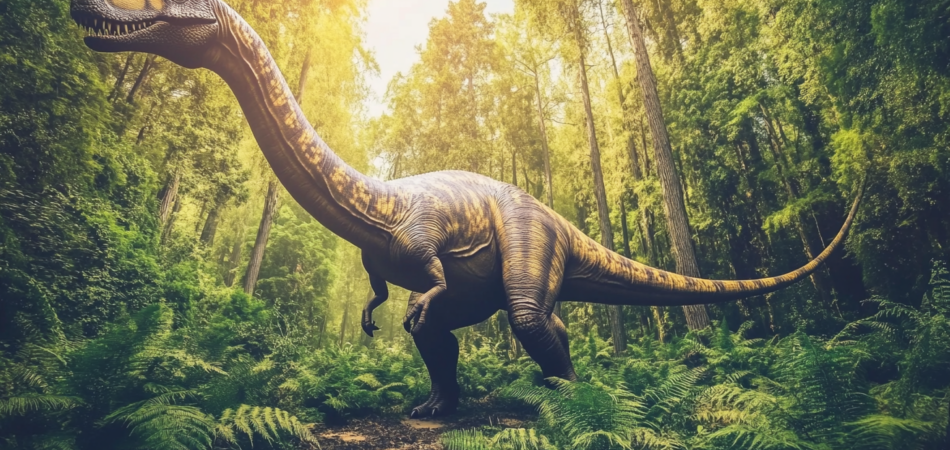
The Brontosaurus, a prominent herbivorous dinosaur from the Late Jurassic period, reaches alarming lengths up to 80 feet. Its long neck allows it to browse treetops, crucial for its diet. Characterized by thick legs and a small skull, it was uniquely adapted for life as a massive sauropod. Confusion with Apatosaurus has persisted, yet recent research reinstated Brontosaurus as a distinct genus. This creature played a significant role in its ecosystem, promoting plant growth and influencing biodiversity. Comprehending its adaptations provides insight into evolution and extinction. You might find more fascinating details by exploring its impact on prehistoric life.
The Brontosaurus represents a remarkable example of herbivorous adaptation during the Late Jurassic period, showcasing its significant role in prehistoric ecosystems.
As one of the largest sauropods, its immense size and long neck allowed it to reach high foliage, which was crucial for its herbivorous diet.
As you explore its massive size and unique features, you’ll uncover how this species influenced both its environment and the evolution of other organisms.
Comprehending the Brontosaurus not only enriches your knowledge of dinosaur biology but additionally highlights its importance in the broader narrative of Earth’s history, particularly as part of the larger group of sauropods.
Known for its impressive stature and distinctive long neck, Brontosaurus stands out as one of the most iconic herbivorous dinosaurs of the Late Jurassic period. This massive creature, reaching lengths up to 75 feet, primarily inhabits open spaces like beaches and southern jungles, where its size makes it easily recognizable.
The Brontosaurus demonstrates fascinating adaptations, such as its long neck, which allows it to reach treetops for foliage—a significant factor in its herbivorous diet.
Brontosaurus behavior is characterized by social interactions; fossil evidence suggests these dinosaurs traveled in herds, likely for protection and resource sharing. During migration, their herd dynamics would have been essential for finding food sources and maneuvering through changing environments.
Furthermore, Brontosaurus interactions with its surroundings include using strong tail sweeps to defend against predators, allowing it to clear obstacles and maintain access to essential resources.
These adaptations define its role in prehistoric ecosystems and highlight its significance as a tank in combat situations, capable of absorbing damage while supporting its group.
Comprehending these aspects of Brontosaurus enriches our appreciation of its place in the evolutionary history of dinosaurs.
Comprehending the Brontosaurus’s role in its ecosystem reveals its significance beyond mere size and appearance. This colossal herbivore served as an essential component in the Late Jurassic environment, influencing both plant life and other species through its feeding habits. By browsing treetops, it facilitated the growth of understory vegetation, highlighting its ecological importance.
The Brontosaurus symbolizes strength and adaptability, making it a formidable figure in both scientific study and popular culture.
The cultural impact of the Brontosaurus extends to literature and media, where it often represents the majesty of dinosaurs, sparking interest in paleontology and biology. Its educational value is immense; studying this dinosaur encourages discussions about evolution, extinction, and the interconnectedness of life.
Additionally, the lessons we draw from the Brontosaurus can inform modern conservation efforts, reminding us of the significance of protecting biodiversity and maintaining healthy ecosystems.
In essence, the Brontosaurus isn’t just a relic of the past; it embodies essential concepts that resonate today, making its study significant for appreciating our natural world and its preservation for future generations.
In 1879, Othniel Charles Marsh first described the Brontosaurus, a name that translates to “thunder lizard.”
This discovery occurred primarily in the Morrison Formation of North America, a rich site for Jurassic fossils.
The Brontosaurus is often confused with the Apatosaurus because of early classification mistakes, which adds to the intrigue of its history.
The ongoing debate surrounding its classification, initially misidentified as a separate species from Apatosaurus, highlights the intricacies of paleontological research and naming conventions.
Sauropods are the most recognized long-neck dinosaurs.
During the late 19th century, paleontologists were captivated by the discovery of fossils in the Morrison Formation, located in the western United States. The Brontosaurus, a massive herbivore, was among the most intriguing finds. Its fossils were unearthed through careful excavation techniques, showcasing the importance of paleontological methods in revealing the Earth’s prehistoric past.
Key aspects of this discovery include:
The 2015 recognition of Brontosaurus as a separate genus from Apatosaurus underscores the evolving nature of paleontological research and highlights the significance of ongoing investigations into these remarkable creatures.
The scientific name of the Brontosaurus, “Brontosaurus excelsus,” directly reflects its impressive stature and significance in paleontological history. The etymology details reveal that “Brontosaurus” translates to “thunder lizard” in Greek, aptly capturing the dinosaur’s massive size and strength presence.
Initially named by paleontologist Othniel Charles Marsh in 1879 amid the fierce Bone Wars, the name Brontosaurus evolved through time, facing historical misconceptions that labeled it merely a species of Apatosaurus because of skeletal similarities.
This name evolution has cultural significance, as Brontosaurus has become synonymous with the image of dinosaurs in popular media, in spite of its scientific identity being clouded for decades.
In 2015, further analysis of fossil evidence reinstated Brontosaurus as a distinct genus, correcting the previous misclassification. Comprehending its linguistic roots enriches your appreciation for how names in science can reflect the essence of the creatures they represent.
The Brontosaurus holds a special place in the narrative of dinosaur research, symbolizing both the intricacies of classification and the excitement of ongoing discovery in paleontology.
Amid the intense rivalry of the late 19th century, a few key paleontologists played crucial roles in the discovery and classification of Brontosaurus. Othniel Charles Marsh initially described this iconic dinosaur in 1879, naming it “Brontosaurus excelsus.” His contributions, set against the backdrop of the Marsh-Cope rivalry, propelled numerous fossil discoveries that greatly impacted dinosaur research evolution.
Here are four pivotal contributions to evaluate:
These developments underscore both the contributions of Marsh and his contemporaries and the broader implications of fossil discoveries on our grasp of dinosaur classifications and their ecological roles.
When examining the Brontosaurus, consider its impressive size and weight, which can reach up to 80 feet in length and 30 tons.
You’ll notice its distinctive features, such as the long neck designed for browsing treetops and the thick, pillar-like legs that support its massive frame.
During theories about its coloration vary, analyzing these physical traits provides insight into how the Brontosaurus adapted to its environment.
Among the largest land animals to ever walk the Earth, Brontosaurus could reach impressive lengths of up to 75 feet (23 meters) and stand about 30 feet (9 meters) tall at the neck.
These dimensions provide a fascinating size comparison with other dinosaurs, highlighting its unique skeletal structure and adaptations.
Weight estimates for the Brontosaurus vary considerably, with adult specimens believed to weigh between 15 to 30 tons (13,600 to 27,200 kg).
This mass allowed it to reach substantial feeding heights, accessing foliage that many other herbivores could not.
Consider these key aspects of Brontosaurus’s size and weight:
Understanding its growth patterns reveals how such a massive creature adapted to its environment, contributing to its role as a dominant herbivore in the Late Jurassic ecosystem.
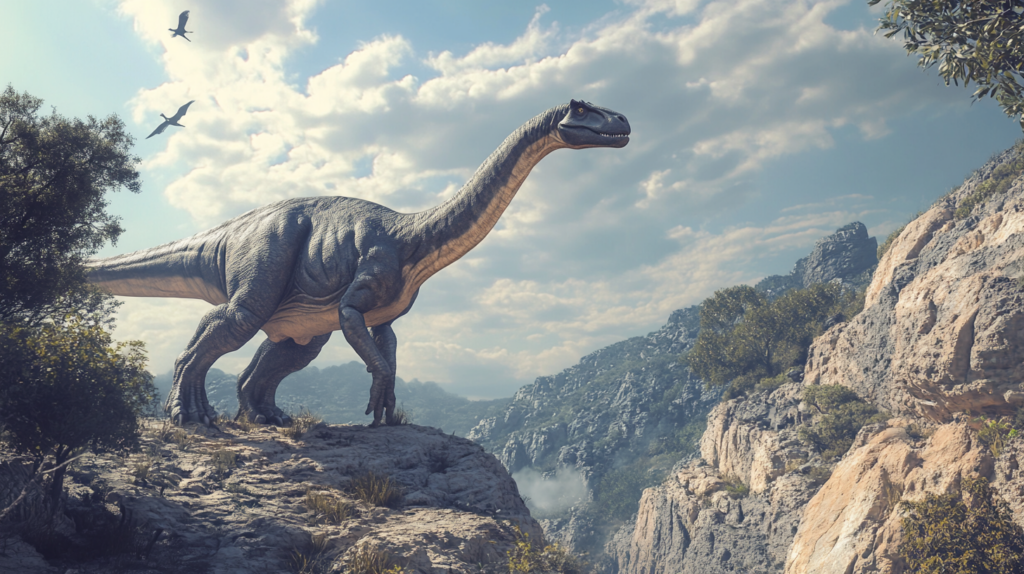
The Brontosaurus’s distinctive features make it an iconic symbol of the Late Jurassic period. This massive herbivore, reaching lengths of up to 85 feet, showcases unique adaptations that improve its survival. Its long neck is a prime example, allowing the Brontosaurus to exploit high vegetation, and developing effective feeding strategies to browse on treetops with ease.
Physically, the Brontosaurus possesses a massive, stocky body supported by four sturdy legs, which are essential for its locomotion techniques. These adaptations enable the dinosaur to support significant weight while traversing its environment, often in herds, highlighting its social interactions.
Moreover, the Brontosaurus boasts a strong tail capable of sweeping motions, serving as a defensive behavior against predators. Its rough, scaly skin provides an additional layer of protection, deterring potential threats.
Collectively, these physical characteristics define the Brontosaurus and illustrate its role in the prehistoric ecosystem, showcasing how evolutionary pressures shaped its unique adaptations for survival in a challenging environment. Comprehending these distinctive features deepens your appreciation of this remarkable creature’s place in the history of life on Earth.
Comprehending the distinctive features of the Brontosaurus naturally leads to an exploration of its coloration theories, which similarly play a significant role in its survival and behavior.
The coloration of this massive herbivore is believed to serve multiple functions, influenced by various factors:
When you examine the classification of Brontosaurus, you’ll find it firmly placed within the Sauropod group, distinguished by its long neck and substantial size.
This dinosaur belongs to the order Saurischia and the family Apatosauridae, indicating its close evolutionary ties to other giants like Apatosaurus and Brachiosaurus.
The Brontosaurus, like other sauropodomorphs, showcases adaptations for gigantism that developed during the Jurassic period, allowing it to thrive in various ecological niches.
Comprehending these taxonomic relationships provides insight into the broader evolutionary framework that shaped the diverse life forms of the Jurassic period, including the evolutionary history and adaptations of early sauropodomorphs.
To understand the Brontosaurus, you need to examine its taxonomic classification, which provides insight into its evolutionary relationships.
It sits within the Kingdom Animalia, Phylum Chordata, and Class Reptilia, before being classified in the Order Sauropod and Suborder Sauropodomorpha.
This structured hierarchy not just reflects its biological characteristics but additionally helps contextualize its role in the prehistoric ecosystem.
The Brontosaurus, a remarkable example of dinosaur evolution, belongs to the kingdom Animalia, which includes all multicellular organisms that are primarily heterotrophic and exhibit motility at various life stages.
Key kingdom characteristics include:
Understanding the kingdom classification of the Brontosaurus reveals its role in the broader context of kingdom evolution and diversity.
Brontosaurus belongs to the phylum Chordata, a classification that encompasses all animals possessing key anatomical features such as a notochord and a dorsal nerve cord.
Its evolutionary significance lies in its anatomical adaptations, which allowed it to plunge in diverse ecosystems.
Fossil evidence and phylogenetic analysis reveal its ecological impact, helping us understand the interconnectedness of prehistoric life and the evolutionary history of vertebrates.
Classifying Brontosaurus reveals its place within the broader context of reptilian evolution. Comprehending its classification systems helps you appreciate its unique traits:
These factors illustrate Brontosaurus’s role in ancient ecosystems.
In the domain of dinosaur classification, comprehending the order Saurischia is crucial for grasping the evolutionary significance of the Brontosaurus. The Saurischia order is divided into two major subgroups: the theropods, which include many of the carnivorous dinosaurs, and the sauropodomorphs, to which the Brontosaurus belongs. Understanding this classification not only highlights the unique characteristics of the Brontosaurus but also allows for a deeper exploration of its ecological role during the Late Jurassic period. For instance, while examining parasaurolophus facts and features, one can appreciate the diversity and adaptability of these prehistoric creatures, shedding light on their interactions within ancient ecosystems.
This order, characterized by its lizard-like hips, encompasses the massive herbivore’s locomotion adaptations, enabling it to thrive in diverse habitats.
Its diet of treetop foliage and herd behavior illustrates the Brontosaurus’s evolutionary strategies, reflecting the intricate relationships within prehistoric ecosystems.
The classification of Brontosaurus within the suborder Sauropodomorpha provides key insights into its evolutionary lineage and physiological traits.
Key characteristics of this suborder include:
These features illustrate the suborder’s remarkable evolutionary diversity and adaptations.
Belonging to the family Sauropod, Brontosaurus exemplifies the remarkable adaptations and characteristics that define this group of massive, herbivorous dinosaurs.
Its family dynamics likely involved complex social behavior, with Brontosaurus demonstrating significant group interactions.
The familial structures may have cultivated strong kin relationships, ensuring mutual support during foraging and providing safety in numbers, pivotal for survival in their Late Jurassic environment.
Brontosaurus represents a significant genus within the classification of dinosaurs, particularly under the family Sauropod.
Its classification history reveals:
Classifying the Brontosaurus within the broader context of dinosaur taxonomy reveals its significance among the sauropods. This species, known scientifically as Brontosaurus superior, exhibits notable adaptations that facilitated its herbivorous diet. Its habitat consisted of lush forests, where it communicated within herds, displaying migratory behavior to optimize resource access.
| Classification | Details | Significance |
|---|---|---|
| Kingdom | Animalia | Fundamental life forms |
| Phylum | Chordata | Backbone presence |
| Family | Diplodocidae | Evolutionary relationships |
| Behavior | Herding | Social interaction |
The classification of Brontosaurus reveals fascinating connections within the vast diversity of sauropod dinosaurs. Recognized as part of the Macronaria family, Brontosaurus shares characteristics with several relatives that highlight the evolutionary adaptations of long-necked herbivores.
By examining fossil comparisons, you can gain clarity into how these species thrived during the Late Jurassic to Early Cretaceous periods.
Here are four notable Brontosaurus relatives:
These species exemplify sauropod diversity and the specific morphological traits that defined the Macronaria lineage, enriching our comprehension of their ecological roles and evolutionary history.
Though often overshadowed by its more famous relatives, the evolutionary relationships within the sauropod lineage provide critical insights into the classification of Brontosaurus. As part of the suborder Sauropodomorpha, Brontosaurus shares common ancestry with other long-necked giants like Apatosaurus and Diplodocus. The fossil record plays a crucial role in uncovering these connections, revealing distinct skeletal features that differentiate Brontosaurus from its close relatives.
Recent phylogenetic analyses, bolstered by genetic studies, have reinstated Brontosaurus as a separate genus. This classification stems from its unique evolutionary adaptations, which include specific morphological diversity that highlights its herbivorous lifestyle and colossal size.
By examining the physical characteristics and evolutionary traits of Brontosaurus, scientists can better comprehend how these adaptations contributed to its ecological success during the Late Jurassic period.
Furthermore, ongoing research continues to refine our perception of sauropod relationships, illustrating how Brontosaurus fits into the broader narrative of dinosaur evolution. These insights not only improve our grasp of Brontosaurus but also enrich our comprehension of the diverse life forms that once populated our planet.
When you investigate the habitat and distribution of Brontosaurus, you’ll find that it thrived during the Late Jurassic period in diverse environments.
Fossil evidence indicates a wide geographical distribution, suggesting these giants inhabited open spaces with abundant vegetation, crucial for their herbivorous diet.
Analyzing the paleoenvironment reveals how these factors influenced their movements and social behavior within prehistoric ecosystems.
Roaming the Earth during the Late Jurassic period, approximately 154 to 150 million years ago, Brontosaurus thrived in diverse habitats across North America.
This massive herbivore exhibited specific habitat preferences, favoring semi-arid environments rich in lush vegetation. Comprehending its ecological role sheds light on its behavior and interactions within the ecosystem.
You can consider the following aspects of Brontosaurus during this time:
Fossil evidence reveals a fascinating picture of Brontosaurus’s geographical distribution, chiefly centered in North America during the Late Jurassic and early Cretaceous periods. The most prominent fossil site locations, such as the Morrison Formation across Colorado, Wyoming, and Utah, highlight the sedimentary rock formations that preserved these leftovers.
Geographic range analysis shows that, although primarily found in North America, Brontosaurus fossils have additionally been discovered in parts of South America, suggesting a broader paleogeographic distribution.
The fossil evidence indicates that Brontosaurus thrived in floodplain environments, abundant in vegetation, which were ideal for large herbivores. The climate implications of this habitat suggest a warm and humid environment, conducive to lush plant growth.
This vegetation supported not merely Brontosaurus but a diverse array of other dinosaur species, as indicated by the common association of their remains in these fossil sites.
Ultimately, comprehending the geographical distribution of Brontosaurus improves our knowledge of its ecological role and the complex ecosystems in which it lived, offering insights into the evolutionary paths of these magnificent creatures.

During the Late Jurassic period, the Brontosaurus thrived in lush, temperate forests and open woodlands, where abundant vegetation provided ample grazing opportunities. This massive herbivore was particularly well-suited to its paleoenvironment, which underwent significant changes over time.
You’ll find that its habitat and distribution were influenced by various factors:
These paleoenvironmental changes not only shaped the Brontosaurus’s lifestyle but as well contributed to the rich biodiversity of its time, highlighting the interconnectedness of life in these ancient ecosystems.
Grasping these dynamics improves our comprehension of evolutionary history.
Examining the paleobiology of the Brontosaurus reveals fascinating insights into its physiology and behavior. This iconic dinosaur, with its massive size and unique skeletal structure, provides a glimpse into the life of herbivorous dinosaurs during the Late Jurassic period.
| Aspect | Description | Significance |
|---|---|---|
| Mobility Patterns | Slow-moving, likely traveled in herds | Improved foraging and protection |
| Feeding Strategies | High vegetation reach, low-nutrient diet | Adaptation to available resources |
| Social Interactions | Evidence of herd behavior | Potential for complex social structures |
| Reproductive Behavior | Likely similar to other sauropods, nesting in groups | Secured survival of offspring |
Brontosaurus habitat preferences leaned in the direction of lush, forested areas, allowing access to treetops for feeding. Its slow metabolism suited its herbivorous diet, enabling survival on less nutritious plant material. Social interactions suggest that these dinosaurs benefited from group living, increasing safety against predators. Comprehending these aspects of Brontosaurus paleobiology not only improves our knowledge of this dinosaur but additionally sheds light on the ecological dynamics of its time.
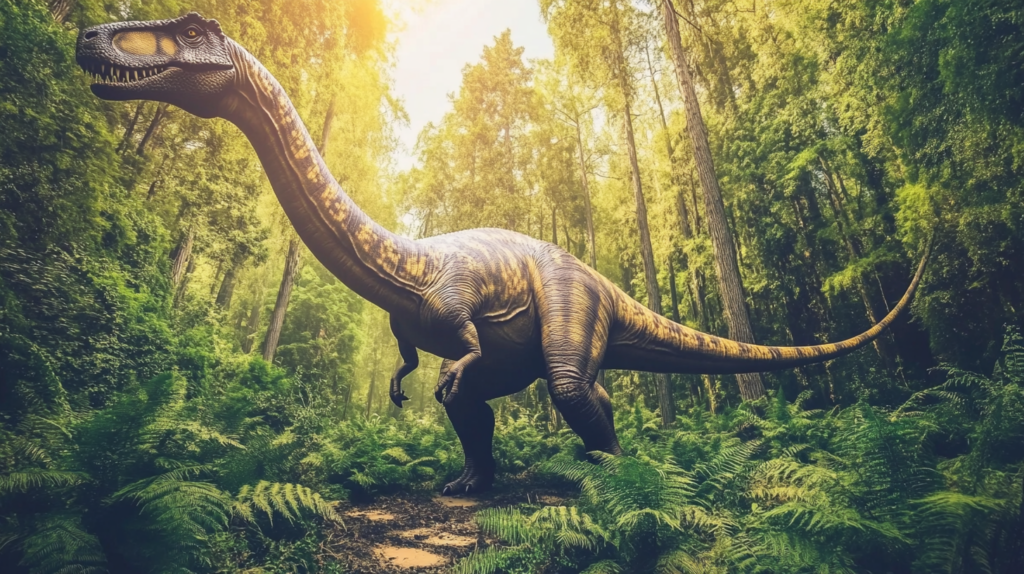
When you observe the Brontosaurus, you’ll notice its unique gait and movement patterns, shaped by its massive size and weight.
Speed estimates suggest this dinosaur moved at a slow pace, which, although not conducive to quick escapes, suited its herbivorous lifestyle.
Its adaptations for terrestrial navigation allow it to traverse various terrains, greatly impacting its role in the ecosystem.
The Brontosaurus showcases a fascinating locomotion pattern that reflects its massive size and unique anatomy. Through gait analysis, we see that its long, column-like legs provide the necessary support for its weight, promoting stability. The dinosaur’s movements are typically slow and deliberate, enhancing movement efficiency as it forages for vegetation over large distances.
Here are some key aspects of Brontosaurus gait and movement patterns:
In this context, comprehending speed variations and how terrain influences movement helps clarify the challenges faced by Brontosaurus, reflecting its evolutionary adaptations to a complex ecosystem.
Brontosaurus locomotion is characterized by a combination of speed and efficiency, particularly notable given its massive size. Although this dinosaur isn’t the fastest, it offers a unique balance of movement efficiency and terrain navigation.
| Aspect | Details |
|---|---|
| Base Walking Speed | 4.5 to 5.0 m/s |
| Sprinting Speed | 7.0 to 8.0 m/s (with rapid stamina loss) |
| Turning Radius | Relatively wide, limiting quick changes |
| Advantages | High health and durability during locomotion |
In terms of speed comparison, Brontosaurus’s base walking speed is on the slower end among dinosaurs. Nevertheless, when sprinting, it gains some advantages, albeit at the cost of stamina management. Its large size enables efficient movement through dense foliage, allowing it to maintain forward momentum in spite of obstacles. While it struggles with rapid direction changes because of its wide turning radius, its durability compensates for speed deficits. Consequently, although Brontosaurus may not be the quickest, its ability to navigate various terrains effectively guarantees it thrives in its environment, showcasing a fascinating blend of locomotion traits.
Adapting to a terrestrial lifestyle, Brontosaurus showcases a range of anatomical features that facilitate efficient movement on land. Its evolutionary significance lies in its remarkable adaptations, allowing it to thrive in diverse prehistoric ecosystems.
Key features include:
While its terrestrial adaptations are finely tuned, Brontosaurus exhibits arboreal limitations, lacking the ability to climb, and faces aquatic challenges as a result of its weight and body structure.
These specialized adaptations underscore its ecological roles as a primary consumer, demonstrating a balance within its environment. Comprehending these traits amplifies our appreciation of how such magnificent creatures adapted to their surroundings, showcasing the intricate relationships within prehistoric ecosystems.
When examining the sensory capabilities of the Brontosaurus, you’ll find that its brain size and structure play an essential role in processing environmental stimuli.
The positioning of its large eyes provides a broad visual field, whereas its sharp olfactory abilities improve its foraging strategies.
Furthermore, comprehending its auditory capacity reveals insights into how these massive creatures communicated within their herds.
In light of its massive size, the brain of the Brontosaurus is relatively small, weighing only about 1 kilogram—roughly the size of a grapefruit. This apparent discrepancy raises questions about brain evolution in such large creatures. The Brontosaurus’ brain structure indicates a high degree of specialization, particularly in sensory processing.
Here are four key aspects of its brain structure and function:
These adaptations reflect the Brontosaurus’ evolutionary responses to its ecological niche, balancing sensory needs with behavior limitations inherent in its brain size.
The sensory capabilities of the Brontosaurus played an important role in its survival and interaction with its environment. In spite of significant visual limitations, this massive dinosaur excelled in olfactory detection and auditory communication, vital for foraging and social interaction.
| Sensory Capability | Description | Importance |
|---|---|---|
| Vision | Poor eyesight, limited to detecting movement | Relies on other senses for navigation |
| Hearing | Sensitive to low-frequency sounds | Facilitates long-distance communication |
| Smell | Highly developed sense of smell | Aids in locating food and detecting threats |
Brontosaurus adapted to its surroundings through these improved sensory abilities. Its olfactory detection allowed it to identify food sources and other dinosaurs from afar, optimizing foraging efficiency. In addition, its auditory capabilities enabled low-frequency communication, necessary for social bonding within herds. Although not particularly agile, the Brontosaurus could sense vibrations in the ground, alerting it to nearby predators, thereby improving its environmental interaction. This combination of strong sensory adaptation made certain the Brontosaurus could effectively navigate its habitat, balancing its size with the need for awareness of its surroundings.
Comprehension of thermoregulation in Brontosaurus reveals how this colossal herbivore thrived in its warm, tropical environment. Its impressive size contributed considerably to its thermoregulatory adaptations, enabling it to maintain a stable internal temperature regardless of external fluctuations.
Here are some key aspects:
These adaptations were essential for surviving in a habitat where temperature variations could be notable.
The long neck of Brontosaurus permitted it to access higher vegetation, avoiding ground-level heat fluctuations, further enhancing its ability to thrive in its environment.
Grasping these mechanisms offers valuable insights into the energy management strategies of large herbivores.
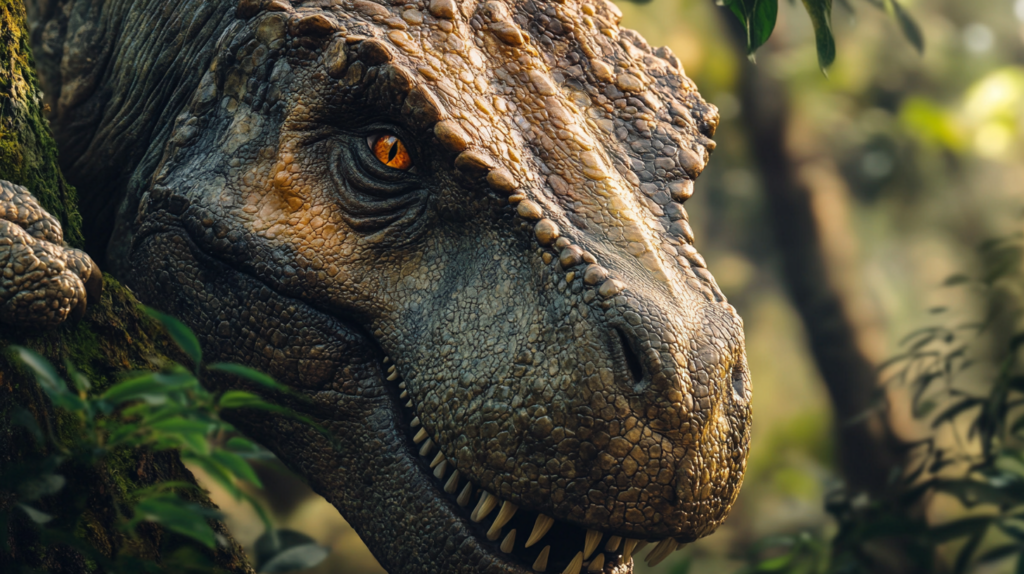
The Brontosaurus, classified as a herbivore, exhibits specific dietary preferences that reflect its adaptation to a plant-based diet.
With a strong inclination towards berries like Mejoberries and the ability to consume crops, it employs feeding strategies that maximize its energy intake from available vegetation.
Comprehending these feeding habits is essential for maintaining its health and ensuring its survival in a prehistoric ecosystem.
Comprehension of the diet and feeding habits of the Brontosaurus reveals its classification as a herbivore. This massive dinosaur primarily relied on a plant-based diet, demonstrating specific dietary preferences that shaped its feeding strategies and social behavior.
Here are key aspects of its herbivorous lifestyle:
Grasping the specific dietary preferences of the Brontosaurus reveals how its feeding habits supported its massive size and overall health. This colossal herbivore primarily thrived on Exceptional Kibble, demonstrating a strong preference for this nutrient-dense food to sustain its considerable bulk.
In addition to kibble, Brontosaurus additionally indulges in a variety of berries, with Mejoberries often being favored because of their high nutritional value.
To maintain ideal health post-taming, a Brontosaurus requires approximately 1,500 berries. This substantial intake underscores the dinosaur’s high food requirement.
The diversity in its diet extends beyond merely kibble and berries; it can likewise consume carbonemys kibble and archelon algae, showcasing its nutritional preferences for a broader range of sustenance.
Providing a mix of food types, including crops and various berries, is crucial for ensuring the Brontosaurus meets its energy needs. Such diet diversity not just supports its impressive size but also contributes considerably to its overall well-being.
Grasping the feeding adaptations and strategies of the Brontosaurus reveals how this massive dinosaur efficiently processed its substantial food intake. As a herbivore, its behavior is intricately tied to its foraging efficiency and food preferences.
Here are key aspects of its feeding strategies:
These adaptations not just highlight the Brontosaurus’s remarkable ability to sustain itself but also emphasize the importance of a constant food supply, especially during taming.
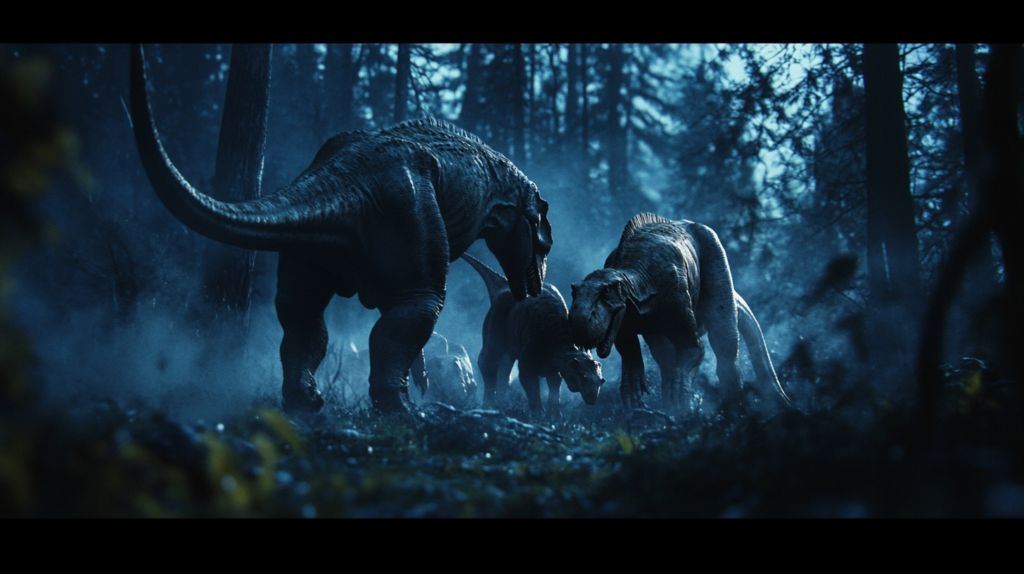
Brontosaurus exhibits notable social behavior, primarily seen in their tendency to form herds that improve foraging efficiency and predator defense.
You’ll find that these herds operate under a matriarchal structure, with older females guiding their young and maintaining group cohesion.
Social behavior among Brontosaurus is evident through their tendency to form large herds, which offers both protection from predators and improved foraging efficiency. Comprehending the dynamics of these herds reveals intricate social structures that may have influenced their survival.
These cooperative strategies not only increased survival rates but additionally encouraged a complex social structure.
By evaluating these behaviors, you gain insight into the evolutionary advantages that such social interactions provided, emphasizing the importance of community in the lives of these massive herbivores.
Grasping these aspects enriches your appreciation of Brontosaurus and their role in the prehistoric ecosystem.
Comprehension of the foraging strategies of Brontosaurus reveals how their social structure supports efficient resource acquisition. These massive herbivores employed various foraging techniques to maximize their dietary intake, primarily targeting vegetation such as leaves and berries. Utilizing their long necks, they reached high foliage and ground plants, showcasing their adaptability in diverse environments.
Brontosaurus often engaged in social foraging, traveling in small herds that improved their gathering efficiency. This herd dynamics not only provided safety in numbers from potential predators but also facilitated cooperative feeding strategies. When foraging, they could clear substantial areas of vegetation, allowing for the regrowth of plants, which ultimately benefited the ecosystem and reduced resource competition.
Their high gathering efficiency rating for berries (4.3/5) demonstrates the importance of this resource in their diet. Brontosaurus’ gentle nature allowed them to coexist peacefully with other herbivores. Consequently, their non-aggressive behavior enabled them to thrive in shared habitats, further improving their foraging success.
Grasping these behaviors provides insight into how Brontosaurus adapted to their environment and contributed to the intricate balance of their prehistoric ecosystems.
Comprehension of the behavior and social structure of Brontosaurus reveals a fascinating blend of solitary and social tendencies that shaped their existence.
Although these massive herbivores often preferred solitary grazing, their interactions with other species indicate a nuanced social behavior. You might consider the following aspects:
Through these observations, it’s clear that Brontosaurus’ behavior was shaped by both solitary feeding habits and sporadic social behaviors, illustrating a complex balance influenced by environmental conditions and predator encounters.
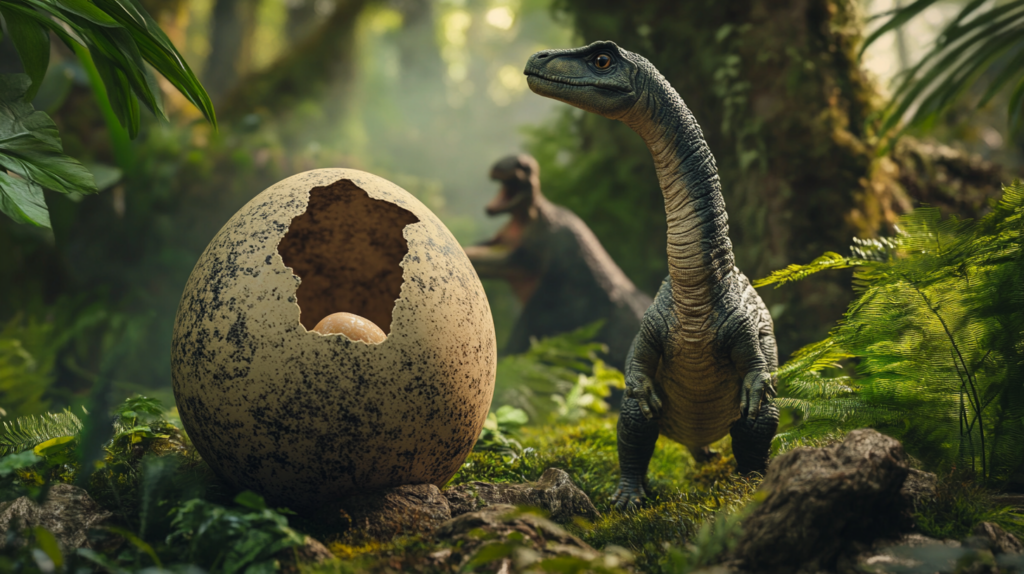
When examining Brontosaurus reproduction, you’ll find that it involves specific mating behaviors and careful nesting practices.
Each female lays a single egg per cycle, necessitating ideal conditions for successful incubation, typically around five hours.
Growth rates are remarkably rapid; from hatchling to adult, a Brontosaurus experiences significant developmental stages within just over nine hours.
Although the exact reproductive habits of Brontosaurus remain largely speculative, evidence suggests that these massive dinosaurs engaged in a well-defined mating process requiring both a male and female. Their reproductive cycle likely included several key components:
These elements illustrate the intricacies of Brontosaurus reproductive habits, highlighting how temperature regulation and parental care played crucial roles in ensuring the survival of their young.
Comprehending these aspects enriches our knowledge of their biology and ecological significance in the Late Jurassic period.
Brontosaurus eggs, typically laid in nests constructed in soft, moist soil, require careful attention to guarantee successful hatching. The ideal temperature for egg incubation ranges from 82 to 88°F (28 to 31°C), and maintaining this temperature is imperative.
During the nesting behavior, a female Brontosaurus shows considerable parental care, monitoring the nest to protect against egg predation. The eggs, with distinct egg morphology, must be kept in a stable environment to guarantee the embryos develop properly.
After a successful breeding, a female must wait about 18 hours before breeding again, which influences her reproductive cycle. Once the eggs are laid, they need constant monitoring to prevent temperature fluctuations that could jeopardize the hatchlings.
The maturation time from egg to adult is remarkably swift, taking approximately 9 hours, 15 minutes, and 33 seconds. During the initial stages of life, constant feeding assistance from a Maewing is fundamental for the hatchlings’ growth until they reach the juvenile stage.
Comprehending these reproductive strategies and nesting behaviors is significant for grasping the life cycle of the Brontosaurus and the ecological dynamics of its environment.
The growth rates and life stages of the Brontosaurus reveal a fascinating progression from hatchling to adulthood, characterized by rapid development and specific care requirements. Comprehending these stages is vital for appreciating their unique biology and ecology.
Once fully mature, Brontosaurus requires considerably less food, easing management of feeding requirements and allowing for a more independent lifestyle.
This growth trajectory illustrates the remarkable adaptability and resilience of the Brontosaurus within its prehistoric ecosystem.
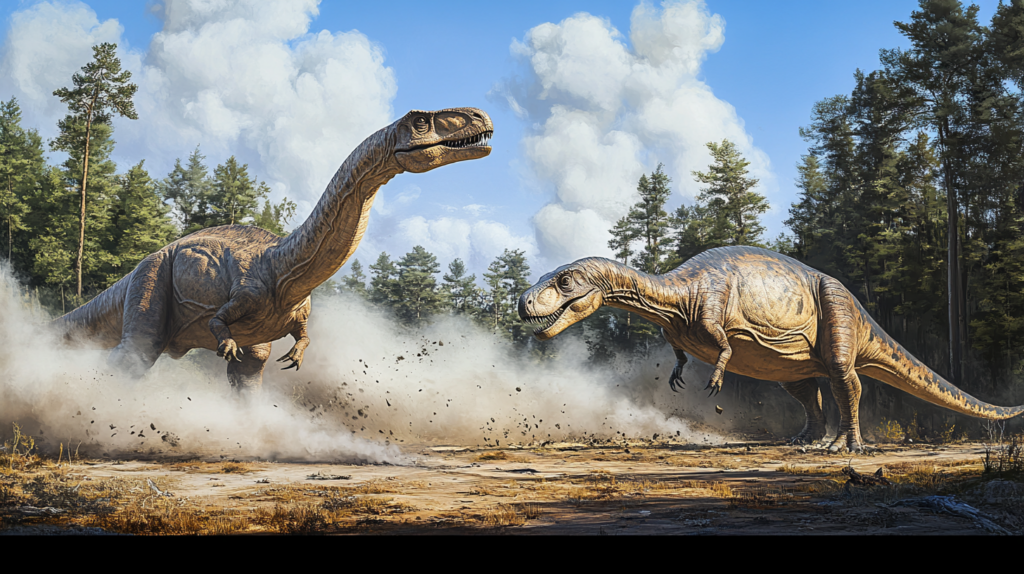
As you explore the Brontosaurus, consider the various threats it faced from predators during the Late Jurassic period.
Although its massive size allowed it to withstand attacks from larger dinosaurs, agile predators like raptors posed significant challenges because of their speed and maneuverability.
The Brontosaurus employed several defense strategies, including its strong tail and herd dynamics, to improve its survival against these threats.
Among the various threats in the Late Jurassic ecosystem, agile predators like Raptors and Allosaurus posed significant challenges for the Brontosaurus. Although these carnivores could outmaneuver a Brontosaurus during attacks, larger predators like T-Rex and Giganotosaurus likewise represented serious dangers, particularly when closing in quickly.
Comprehending these predator interactions is essential for grasping the Brontosaurus’s role in its ecosystem. Here are some known or potential predators:
The Brontosaurus’s high health allowed it to absorb considerable damage, making it an impressive tank.
Nevertheless, utilizing smaller, agile dinosaurs alongside the Brontosaurus could improve defense strategies, distracting predators while the Brontosaurus executed its survival tactics.
Grasping these dynamics reveals the complex behavioral adaptations that enabled the Brontosaurus to navigate its perilous environment.
Comprehension of the threats posed by predators highlights the significance of the Brontosaurus’s defense strategies and adaptations. This massive herbivore employs several effective defensive formations to counter various threats in its environment. Its sheer size acts as a tank strategy, absorbing damage during predator encounters.
When faced with smaller predators, the Brontosaurus utilizes its potent tail sweep, which can repel attackers and protect nearby allies. In cases of predator engagement, the Brontosaurus can effectively tackle larger threats, but it’s vital to avoid agile predators that can outmaneuver it.
By strategically positioning itself in battle zones, the Brontosaurus can likewise function as a distraction tactic, drawing attention away from more vulnerable allies. This allows for safe escapes or repositioning without incurring damage.
Moreover, when Brontosaurus cooperates with smaller, faster dinosaurs like raptors, they form a formidable defense force. This combination improves their collective ability to handle aggressive creatures, utilizing their unique strengths to create a balanced defense system.
Through these adaptations, the Brontosaurus showcases the evolutionary significance of defensive behaviors in prehistoric ecosystems, ensuring survival against formidable threats.
Often overlooked, paleopathology reveals critical insights into the health and lifestyles of extinct species like the Brontosaurus. By examining fossilized remains, researchers uncover paleopathological evidence that provides a glimpse into the challenges these massive creatures faced.
Through fossil analysis, you can learn about various health issues that impacted their survival, including:
Understanding these factors offers valuable health insights into how Brontosaurus navigated their world.
The analysis of these fossilized remains reveals not only individual struggles but also the broader implications of disease on their populations. By studying these ancient health conditions, you gain a deeper appreciation for the intricacies of their lives and the environmental pressures they endured during the Late Jurassic period.
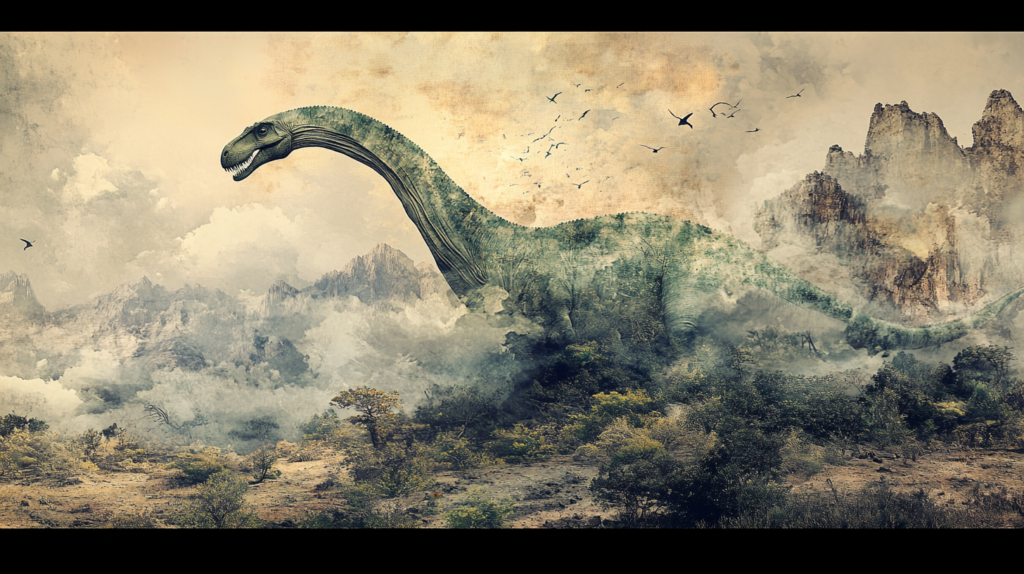
You’ll find that the extinction of the Brontosaurus around 66 million years ago raises significant questions about dinosaur evolution and environmental shifts.
Theories suggest that the impact of an asteroid the role of the asteroid/comet impact and volcanic activity played vital roles in this extinction event, highlighting the complex interplay of factors leading to this extinction event.
Furthermore, Brontosaurus continues to capture public imagination, appearing in popular culture and notable museum exhibits, which further fuels scientific debates about its classification and legacy.
Exploring the extinction theories surrounding the Brontosaurus reveals a complex interplay of environmental factors that contributed to its decline. Several key elements likely played a role in its extinction during the late Cretaceous period:
These theories suggest that the Brontosaurus faced multiple challenges, from direct competition to catastrophic environmental shifts.
Comprehending these extinction factors helps you appreciate the delicate balance of prehistoric ecosystems and the eventual fate of one of its most iconic inhabitants.
The Brontosaurus serves as an essential case study in grasping dinosaur evolution, particularly regarding the intricacies of classification and the adaptive strategies of large herbivores. This massive dinosaur, once misclassified under the genus Apatosaurus, highlights the classification challenges faced by paleontologists. These initial misclassifications can greatly shape scientific discourse, influencing our awareness of evolutionary relationships.
Examining the Brontosaurus reveals important adaptive traits, such as its long neck, which evolved under specific evolutionary pressures favoring larger body sizes. These adaptations allowed it to efficiently forage from treetops, showcasing strategies that were vital for survival in its Late Jurassic environment.
The fossil record, including trackways and nesting sites, provides valuable insight into its behavior and social structures, reflecting the ecological impact of large herbivores on prehistoric ecosystems.
The extinction of the Brontosaurus and its contemporaries at the end of the Cretaceous period further illustrates how catastrophic events can reshape biodiversity and evolutionary trajectories. By studying the Brontosaurus, you gain a deeper appreciation of the dynamic processes that have shaped the history of life on Earth, revealing the complex interplay between adaptation, extinction, and classification in the grand narrative of dinosaur evolution.
Brontosaurus has become a cultural icon, transcending its prehistoric origins to influence modern media and public perception of dinosaurs. Its misclassification as Apatosaurus in the early 20th century merely added to the intrigue surrounding this majestic creature.
You can see the Brontosaurus’s legacy in various aspects of popular culture, which include:
The Brontosaurus’s existence in modern media has sparked conversations about extinction, paralleling contemporary environmental concerns.
This connection not only solidifies its status as a cultural icon but likewise emphasizes the importance of conservation efforts in today’s world.
Many visitors to natural history museums are often captivated by the imposing skeletal reconstructions of the Brontosaurus, which serve as a tribute to the immense size and unique adaptations of these herbivorous giants.
Brontosaurus exhibits showcase fossils primarily extracted from the Morrison Formation in North America, illuminating its role during the Late Jurassic period, approximately 154 to 150 million years ago.
These museum displays emphasize the dinosaur’s staggering dimensions, reaching lengths of up to 75 feet and weights of 15 tons.
Such fossil reconstructions highlight significant physical features, like the long neck and tail, which were essential for foraging in treetops and facilitating communication within herds.
How did the Brontosaurus shift from a misidentified species to a symbol of dinosaur grandeur? This transformation reflects ongoing scientific misconceptions and classification debates that have spanned decades.
Initially, Brontosaurus was deemed a synonym of Apatosaurus, but late 20th-century research revived its status as a distinct genus, igniting paleontological controversies.
Key points of contention include:
Ultimately, the Brontosaurus remains a fascinating example of how fossil interpretations can shape scientific discourse, influencing both academic and popular perceptions of these magnificent creatures.
Recent research has transformed our comprehension of Brontosaurus, revealing intricate details about its feeding habits and social structures.
Ongoing excavations continue to produce new specimens, shedding light on its size and evolutionary adaptations within the sauropod lineage.
As you explore these latest scientific findings, consider how they reshape the narrative of this iconic dinosaur.
New scientific discoveries are reshaping our grasp of the Brontosaurus and its ecological role during the Late Jurassic period. Recent research highlights several key findings that deepen our awareness of this iconic dinosaur:
These findings not merely improve our knowledge of Brontosaurus but additionally provide significant insights into the ecological dynamics of the Late Jurassic period.
Excavations and studies of Brontosaurus are yielding significant discoveries that improve our grasp of this iconic dinosaur’s life and environment. Recent fossil excavation techniques in the western United States have uncovered new sites, revealing crucial insights into Brontosaurus habitats and behaviors during the Late Jurassic period.
Researchers are employing advanced imaging methods to analyze bone structure, uncovering adaptations that supported the dinosaur’s massive size, such as reinforced vertebrae.
Moreover, ongoing dietary analysis methods have examined dental wear patterns, providing evidence of feeding habits and preferences. These findings suggest that Brontosaurus primarily consumed high foliage, indicating specific ecological niches within their environments.
Associated fossils, including those of contemporary plants and herbivores, contribute to ecosystem reconstruction, painting a detailed picture of the habitat in which Brontosaurus flourished.
Intriguingly, evidence points to potential dinosaur social behavior, as multiple individuals have been found closely situated within fossil beds. This suggests that Brontosaurus may have traveled in herds, enhancing our insight into their social structure and interactions.
Collectively, these ongoing excavations and studies deepen our awareness of Brontosaurus and its role in prehistoric ecosystems.
As you explore further information about the Brontosaurus, consider its ecological role and how it compares to modern analogs like giraffes and elephants.
Analyzing its habitat and social behaviors provides insight into the evolutionary adaptations that allowed it to thrive.
Furthermore, fun facts about its size and capabilities highlight the significance of this dinosaur within its ecosystem.
The Brontosaurus, with its towering stature and sturdy physique, epitomizes the grandeur of herbivorous dinosaurs that thrived during the Late Jurassic period. This colossal creature, reaching lengths of up to 75 feet, showcases remarkable adaptations that allowed it to flourish in its environment.
Comprehending the Brontosaurus involves examining several key aspects:
The social structure of the Brontosaurus likely played a vital role in its survival, as traveling in groups offered not merely safety but also opportunities for resource management.
Frequently, modern large herbivores provide valuable insights into the ecological niches once occupied by dinosaurs like the Brontosaurus. Examining species such as the African elephant and giraffe, you can draw parallels in feeding strategies and habitat similarities. Both the Brontosaurus and these modern herbivores occupy high ecological roles, influencing vegetation growth and promoting biodiversity through their interactions.
Niche competition among herbivores today mirrors the dynamics of prehistoric ecosystems. For instance, giraffes exploit tree foliage at heights inaccessible to other grazers, similar to how Brontosaurus used its long neck to reach treetops. In grassland habitats, large grazers like bison prevent overgrowth, maintaining ecosystem health, akin to the grazing patterns of Brontosaurus.
When considering megafauna comparisons, the ecological roles of today’s large herbivores reflect the significant impacts of their extinct counterparts. Both contribute to seed dispersal and nutrient cycling, shaping their environments.
Comprehending these relationships not just illuminates the ecological niches of the past but additionally highlights the importance of conserving modern species that fulfill similar roles in our ecosystems today.
Brontosaurus, often enchanting the imagination of both paleontologists and enthusiasts alike, showcases a fascinating array of characteristics that highlight its unique adaptations to a prehistoric environment. This colossal dinosaur, reaching lengths of up to 75 feet and weighing around 30 tons, thrived in diverse habitats during the Late Jurassic period.
Here are some intriguing facts about Brontosaurus:
Understanding these aspects of Brontosaurus enriches our knowledge of prehistoric ecosystems and the evolutionary adaptations that shaped life millions of years ago.
Brontosaurus isn’t used much anymore because of classification changes stemming from fossil discovery history, paleontological debates, and its confusing status among museums, which often prioritize accurate displays reflecting current dinosaur popularity trends.
Taming a Bronto’s definitely worth it. Its saddle benefits improve mobility and resource management, as utility roles aid in gathering. Plus, breeding advantages guarantee a strong lineage, making it a strategic asset for your endeavors.
The Brontosaurus, reaching up to 75 feet, primarily consumed leaves from tall trees. It thrived in lush habitats during the Late Jurassic, exhibiting herd behavior. Eventually, changes in climate and vegetation contributed to its extinction.
To take down a bronto, you’ll need 25 to 80 tranq darts, depending on its health. Utilizing ideal bronto traps improves tranq dart effectiveness whereas comprehending bronto behavior patterns aids in successful taming and post-tame usage.
To summarize, the Brontosaurus remains a enthralling subject of study, embodying the complex interplay of evolution and ecology during the Late Jurassic period. Its massive size and unique adaptations highlight the evolutionary pressures of its environment, whereas its social behavior offers insights into herd dynamics of prehistoric herbivores. As ongoing research uncovers new findings, the Brontosaurus not solely enriches our comprehension of dinosaur biology but additionally serves as a reminder of the diverse life forms that once inhabited our planet.